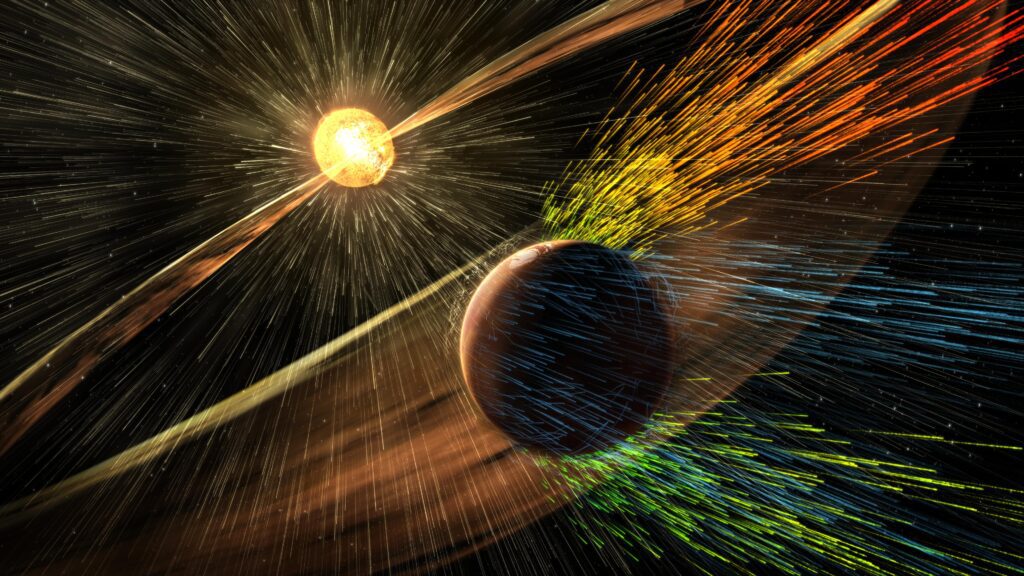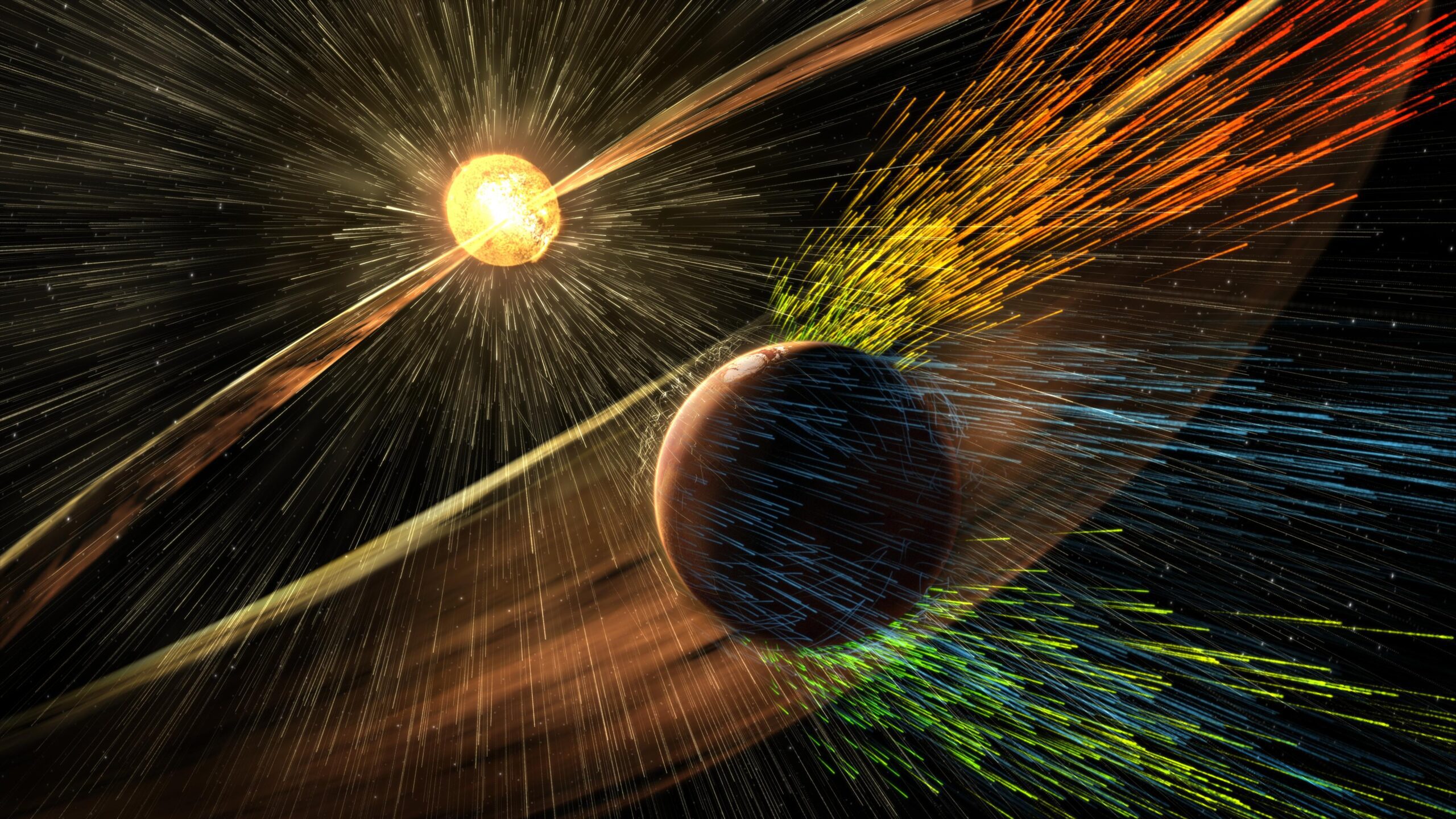Mars solar storm, radiation risks, Mars astronauts, Curiosity rover, MAVEN orbiter, solar flare, coronal mass ejection, space weather, Martian auroras, NASA Mars missions
Discover the insights gained from the recent extreme solar storm on Mars, including the radiation risks for future astronauts and the protective strategies being developed. Learn about the impact on Mars’ rovers and orbiters and the fascinating Martian auroras observed by NASA’s MAVEN orbiter.

In a significant development for space science, a recent extreme solar storm has provided invaluable insights into the radiation risks that future astronauts might face on Mars. This storm, marked by intense solar flares and coronal mass ejections, has not only illuminated the Martian skies with auroras but also offered crucial data on the radiation exposure in deep space.
Solar Maximum and the Anticipated Solar Storms
Earlier this year, the Sun entered a period of peak activity known as solar maximum. This phase has been anticipated by Mars scientists, who have been closely monitoring the Sun for any signs of increased solar activity. Over the past month, NASA’s Mars rovers and orbiters have observed a series of solar flares and coronal mass ejections impacting Mars, creating an unprecedented opportunity for research.
The May 20 Solar Event
The most significant event occurred on May 20, with a solar flare that was later estimated to be an X12 — X-class solar flares being the most powerful type. This flare, detected by the Solar Orbiter spacecraft (a joint mission by ESA and NASA), sent out X-rays and gamma rays toward Mars. Following this, a coronal mass ejection launched charged particles that reached Mars in just tens of minutes.
NASA’s Moon to Mars Space Weather Analysis Office at Goddard Space Flight Center tracked this space weather event closely. They identified the potential for incoming charged particles, which would have been a significant radiation dose for any astronauts on the Martian surface.
Radiation Exposure and Protection Strategies
Had astronauts been present near NASA’s Curiosity rover during this event, they would have experienced a radiation dose of 8,100 micrograys, equivalent to about 30 chest X-rays. While not fatal, this was the highest surge recorded by Curiosity’s Radiation Assessment Detector (RAD) since its landing 12 years ago.
This data is crucial for planning future manned missions to Mars. Scientists are considering various protective measures, including utilizing Mars’ natural landscapes like cliffsides or lava tubes to shield astronauts from such high radiation levels. Don Hassler, RAD’s principal investigator, suggests that the dose rate would be significantly higher in Mars orbit or deep space, emphasizing the need for robust protection strategies.
The Impact on Mars Rovers and Orbiters
The May 20 solar event had a noticeable impact on Mars’ rovers and orbiters. Curiosity’s navigation cameras recorded images with “snow” effects, caused by charged particles striking the cameras. Similarly, NASA’s Mars Odyssey orbiter’s star camera was temporarily overwhelmed by the energy from the solar particles, though it recovered within an hour.
Odyssey’s High-Energy Neutron Detector collected vital data on the X-rays, gamma rays, and charged particles, continuing its long history of contributing to our understanding of solar flares.
Auroras Over Mars
High above the Martian surface, NASA’s MAVEN (Mars Atmosphere and Volatile EvolutioN) orbiter observed the auroras caused by the recent solar activity. Unlike Earth, where auroras are confined to polar regions due to the planet’s magnetic field, Mars experiences auroras that can engulf the entire planet. This is because Mars lost its global magnetic field in the ancient past, leaving its atmosphere exposed to energetic particles from the Sun.
During the solar event, MAVEN’s Solar Energetic Particle instrument recorded the particles causing the auroras. This data allows scientists to reconstruct the timeline of the event, providing a detailed picture of how the solar particles interacted with Mars.
Future Mars Missions and Continued Research
The data collected by NASA’s Mars missions is not only vital for understanding current space weather events but also for future planetary missions. Upcoming missions like ESCAPADE (Escape and Plasma Acceleration and Dynamics Explorers), set to launch in late 2024, will provide even more detailed observations of space weather around Mars with its twin small satellites.
These missions, along with contributions from other heliophysics missions like Voyager and Parker Solar Probe, are expanding our knowledge of solar activity and its effects on planetary environments.
Conclusion
The recent extreme solar storm has provided a wealth of information on the radiation risks that future astronauts on Mars might face. By studying these events in detail, scientists can develop better protection strategies and ensure the safety of astronauts in deep space. The continuous monitoring and research by NASA’s spacecraft will pave the way for safer and more successful manned missions to the Red Planet.
Read More
- NASA Prepares for Crucial Spacewalks to Repair and Upgrade International Space
- NASA Awards Cutting-Edge Technologies for Future Habitable Worlds Mission
- NASA PREFIRE Mission: Tiny Satellites Measuring Earth’s Polar Heat Loss
- NASA and IBM Research Unveil Cutting-Edge AI Model for Weather and Climate Forecasting










